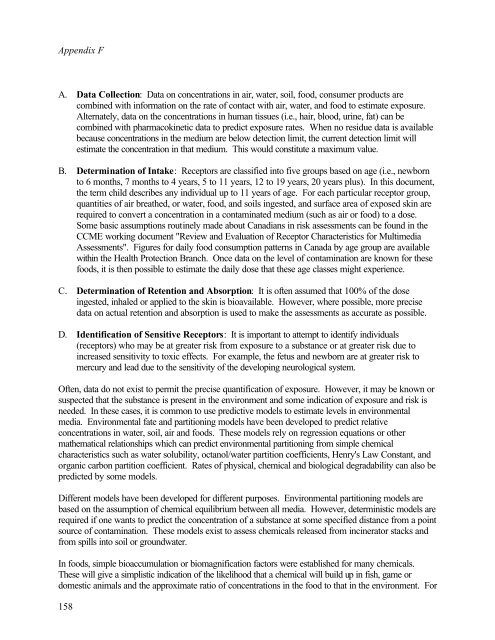Protocol for the Derivation of Environmental and Human ... - CCME
Protocol for the Derivation of Environmental and Human ... - CCME
Protocol for the Derivation of Environmental and Human ... - CCME
Create successful ePaper yourself
Turn your PDF publications into a flip-book with our unique Google optimized e-Paper software.
Appendix F<br />
A. Data Collection: Data on concentrations in air, water, soil, food, consumer products are<br />
combined with in<strong>for</strong>mation on <strong>the</strong> rate <strong>of</strong> contact with air, water, <strong>and</strong> food to estimate exposure.<br />
Alternately, data on <strong>the</strong> concentrations in human tissues (i.e., hair, blood, urine, fat) can be<br />
combined with pharmacokinetic data to predict exposure rates. When no residue data is available<br />
because concentrations in <strong>the</strong> medium are below detection limit, <strong>the</strong> current detection limit will<br />
estimate <strong>the</strong> concentration in that medium. This would constitute a maximum value.<br />
B. Determination <strong>of</strong> Intake: Receptors are classified into five groups based on age (i.e., newborn<br />
to 6 months, 7 months to 4 years, 5 to 11 years, 12 to 19 years, 20 years plus). In this document,<br />
<strong>the</strong> term child describes any individual up to 11 years <strong>of</strong> age. For each particular receptor group,<br />
quantities <strong>of</strong> air brea<strong>the</strong>d, or water, food, <strong>and</strong> soils ingested, <strong>and</strong> surface area <strong>of</strong> exposed skin are<br />
required to convert a concentration in a contaminated medium (such as air or food) to a dose.<br />
Some basic assumptions routinely made about Canadians in risk assessments can be found in <strong>the</strong><br />
<strong>CCME</strong> working document "Review <strong>and</strong> Evaluation <strong>of</strong> Receptor Characteristics <strong>for</strong> Multimedia<br />
Assessments". Figures <strong>for</strong> daily food consumption patterns in Canada by age group are available<br />
within <strong>the</strong> Health Protection Branch. Once data on <strong>the</strong> level <strong>of</strong> contamination are known <strong>for</strong> <strong>the</strong>se<br />
foods, it is <strong>the</strong>n possible to estimate <strong>the</strong> daily dose that <strong>the</strong>se age classes might experience.<br />
C. Determination <strong>of</strong> Retention <strong>and</strong> Absorption: It is <strong>of</strong>ten assumed that 100% <strong>of</strong> <strong>the</strong> dose<br />
ingested, inhaled or applied to <strong>the</strong> skin is bioavailable. However, where possible, more precise<br />
data on actual retention <strong>and</strong> absorption is used to make <strong>the</strong> assessments as accurate as possible.<br />
D. Identification <strong>of</strong> Sensitive Receptors: It is important to attempt to identify individuals<br />
(receptors) who may be at greater risk from exposure to a substance or at greater risk due to<br />
increased sensitivity to toxic effects. For example, <strong>the</strong> fetus <strong>and</strong> newborn are at greater risk to<br />
mercury <strong>and</strong> lead due to <strong>the</strong> sensitivity <strong>of</strong> <strong>the</strong> developing neurological system.<br />
Often, data do not exist to permit <strong>the</strong> precise quantification <strong>of</strong> exposure. However, it may be known or<br />
suspected that <strong>the</strong> substance is present in <strong>the</strong> environment <strong>and</strong> some indication <strong>of</strong> exposure <strong>and</strong> risk is<br />
needed. In <strong>the</strong>se cases, it is common to use predictive models to estimate levels in environmental<br />
media. <strong>Environmental</strong> fate <strong>and</strong> partitioning models have been developed to predict relative<br />
concentrations in water, soil, air <strong>and</strong> foods. These models rely on regression equations or o<strong>the</strong>r<br />
ma<strong>the</strong>matical relationships which can predict environmental partitioning from simple chemical<br />
characteristics such as water solubility, octanol/water partition coefficients, Henry's Law Constant, <strong>and</strong><br />
organic carbon partition coefficient. Rates <strong>of</strong> physical, chemical <strong>and</strong> biological degradability can also be<br />
predicted by some models.<br />
Different models have been developed <strong>for</strong> different purposes. <strong>Environmental</strong> partitioning models are<br />
based on <strong>the</strong> assumption <strong>of</strong> chemical equilibrium between all media. However, deterministic models are<br />
required if one wants to predict <strong>the</strong> concentration <strong>of</strong> a substance at some specified distance from a point<br />
source <strong>of</strong> contamination. These models exist to assess chemicals released from incinerator stacks <strong>and</strong><br />
from spills into soil or groundwater.<br />
In foods, simple bioaccumulation or biomagnification factors were established <strong>for</strong> many chemicals.<br />
These will give a simplistic indication <strong>of</strong> <strong>the</strong> likelihood that a chemical will build up in fish, game or<br />
domestic animals <strong>and</strong> <strong>the</strong> approximate ratio <strong>of</strong> concentrations in <strong>the</strong> food to that in <strong>the</strong> environment. For<br />
158
















